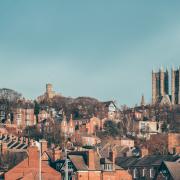Barbara Barr has more reason than most to celebrate Bradford Alhambra’s 100th birthday. For her, it’s not just an iconic entertainment venue, it’s an integral part of her family history.
‘Few people in the city today will remember the original building commissioned by Francis Laidler and built before the First World War at the junction of Morley Street and Great Horton Road,’ she said. ‘It opened on March 23rd 1914 and on opening night, among the front-of-house staff, there was a 14-year-old pageboy named Rowland Hill, who was to play a very special part in the life of the theatre for the next 60 years. Rowland Hill was my father.’
Barbara was born in Bradford in 1929, followed four years later by her sister Pattie, and throughout their childhood and beyond their father’s life revolved around the city’s famous theatre.
He slowly worked his way up through the ranks until he was appointed co-director alongside Francis Laidler in 1938. His mentor died in 1955 and, in 1964, his widow put the Alhambra up for sale.
‘Bradford City Council eventually bought the building and there was much speculation about what to do with it,’ said Barbara. ‘My father finally managed to persuade the council to lease the property to him.’
It was a difficult time. Theatres and cinemas were closing all over the country with the popularisation of television, and, locally, families were starting to feel the pinch as Bradford’s wool trade fell into decline and mills started to close.
‘From 1964 to 1975 my father worked tirelessly to keep the Alhambra afloat,’ said Barbara. ‘It was only when touring companies became too expensive that he decided to retire, just a few months shy of his 75th birthday.
‘In retrospect I wonder how he felt handing over the keys to the council, saying goodbye to 60 years of his life and not knowing whether his efforts to keep the theatre alive would be successful.’
In the end, an £8 million refurbishment grant from the EU helped to secure the Alhambra’s future and resulted in the beautiful theatre that brightens the Bradford skyline today.
‘The 100th birthday of the Alhambra seems a good time to pay tribute to my father for all his efforts,’ said Barbara. ‘You have to admire his sheer determination to retain an important part of the history of the city and to keep alive an essential part of its cultural life.’
On the bill
The Alhambra is celebrating its centenary with an impressive line-up of hit shows including War Horse, One Man Two Guvnors, Singin’ in the Rain and The Lion King – the only Yorkshire venue to secure the smash hit musical this season.
Also on the bill are Fiddler On The Roof starring Paul Michael Glaser, one half of iconic US cop duo Starsky and Hutch, as Tevye; Brassed Off, based on the hit movie and starring former Brookside and Waterloo Road actor John McArdle; Blood Brothers, Willy Russell’s much-loved Liverpool-based musical tragedy; and Matthew Bourne’s provocative take on Swan Lake featuring an all-male swan ensemble.
In a slight twist, the Alhambra’s restaurant is going to take centre stage by hosting a series of dinner shows, including James Bond parody Shaken Not Stirred and Fawlty Towers, during which diners will have the dubious pleasure of being served by Basil, Sybil and the hilariously hapless Manuel.
‘It’s an honour for me to be general manager of this prestigious theatre in such a wonderful year,’ said Adam Renton, general manager of Bradford Theatres, which also includes St George’s Concert Hall, The Studio and King’s Hall & Winter Garden.
‘Everyone at Bradford Theatres is planning a year of celebration to acknowledge this magnificent milestone.’
Setting the scene
- The Alhambra was built, at a cost of £20,000, in 1914 on the site of the ‘Morley Street Waste’.
- It was officially opened at 2pm on March 14th, opening its doors to the general public on March 23rd for a week-long variety show featuring Yeadon-born comic Sydney Howard and the acrobatic Benedetti Brothers.
- The name Alhambra derives from the Arabic ‘kal-el-at-ambra’, which means red domed castle.
- Early in its history, the only advance ticket sales were for the boxes, leading to the name ‘Box Office’.
- The stalls used to have no formal seating, only benches and chairs at the front. The dress circle contains what were, at the time, the best seats in the house and is so called because you were expected to wear formal attire. And the upper circle is known as The Gods because of the plaster Gods holding up the ceiling.
- The seating capacity of the Alhambra is 1,456 in a style known as continental (no centre aisle or pillars in the stalls).
- The Alhambra has three star dressing rooms called Cinderella, Mother Goose and Humpty Dumpty.
- Among the key early stars to appear at the Alhambra were Laurel & Hardy, George Formby, prima ballerina Anna Pavlova and singer Randolph Sutton.
- ‘The Alhambra has a tremendous history and significance to Bradford people,’ said Councillor Susan Hinchcliffe of Bradford City Council. ‘I’m looking forward to this year and the blockbuster shows we have coming. Tickets are selling really fast so there will be literally thousands of people joining in the celebration.’



























